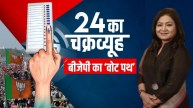Bharat Ek Soch: Why are people in our country falling ill at an alarming rate? How is the number of patients increasing day by day? In such a scenario, it is crucial to understand the changes happening in the healthcare system.
Taking care of the health of a billion forty crore people is no easy task. Everyone wants the best possible treatment for themselves and their loved ones. In a democratic system, the concern for better healthcare has been well understood by political parties, and several schemes guaranteeing free treatment are being implemented nationwide. Both the central and state governments have their own initiatives. However, today, we are not counting the schemes that provide free treatment and medication.
Why are people in our country falling ill at an alarming rate?
How is the number of patients increasing day by day? In such a scenario, it is crucial to understand the changes happening in the healthcare system and the increasing role of technology within it. Is healthcare expensive or affordable in a country like India compared to other nations? Can it be made even more affordable? What should be the ideal healthcare system for everyone? In today’s date, what kind of system is needed where people don’t have to rush to large hospitals for minor illnesses? What path should be shown to people so that they need to take fewer medicines? What should be done to make healthcare even more affordable for the people?
Dealing with various difficulties in the current healthcare system of the country, let’s first understand the challenges individuals face when seeking medical treatment. Imagine a common farmer in a remote village in places like Gopalganj, Bihar, or Basti, Uttar Pradesh, experiencing chest pain or breathing problems. What will they do? Can they get treatment at a primary health center located a few kilometers away from the village, or should they travel to district hospitals for better treatment? In such a situation, they have two options – one, they continue to live with their ailment and suffer, and the other is to reach Patna or Varanasi for medical treatment if their financial condition improves. This means incurring substantial expenses. If they ever need to be admitted to a hospital, the bill can run into lakhs. However, if the farmer’s pocket is empty, he will keep making trips to government hospitals from Patna to Delhi. In this scenario, we should ask whether it is right for the healthcare system in the country to remain as it is at its foundation.
Three to four days, and you will be completely fine
A few years ago, in a major hospital in Delhi, renowned political scientists were admitted for treatment, with round-the-clock nursing care. However, on the third day, they joined their hands in front of the doctors and asked to be discharged. The doctors said their health was rapidly improving, and in three to four days, they would be completely fine. In response, the patient said that if they were not discharged, they would die from the hospital bills. The political scientist I was referring to is no longer in this world. While it is claimed that medical treatment in India is cheaper compared to many other countries worldwide, we should also examine the per capita income of the countries we are comparing to. In this context, it raises the question of how much more affordable the healthcare system in the country can be made. Can people be freed from expensive tests and treatments?
Expending 2% of GDP on healthcare
In terms of healthcare spending as a percentage of GDP, the United States allocates 14.8%, China 17.7%, and the United Kingdom 10.6%. However, in India, healthcare accounts for around 2% of the GDP. Health experts believe that in order to strengthen the healthcare infrastructure in the country, it should be increased to 5% of the GDP. The world of medicine is rapidly evolving, encompassing technologies like robotic surgery. Nevertheless, India still faces a shortage of doctors and paramedical staff. In this regard, the question arises whether the government will bring about changes in medical education to produce more capable doctors within the country.
Facing resource constraints at times
The relationship between patients and doctors is built on trust; any patient entrusts their most precious possession, their body, to a doctor. However, at times, due to resource constraints or management-related issues, this trust appears to waver. In such cases, one may question whether there should be something like the All India Medical Services, similar to the Indian Administrative Service, Indian Police Service, and Indian Forest Service. After independence, the Mudaliar Committee recommended the establishment of a separate health cadre. In 1973, the Kartar Singh Committee elaborated on this idea. At different times, various committees have proposed bringing health services to the forefront and creating a public health management cadre for better resource management. This raises the question of whether efforts will be made to consolidate medical services and management under one umbrella. In our country, we have had a tradition of treatment through Ayurveda for thousands of years, which also includes surgical procedures. In recent years, the government has been promoting Ayurveda. Postgraduate Ayurvedic doctors have even received permission to perform surgeries for several diseases. Could we not pave a path where no particular method of treatment claims superiority over others, focusing on maintaining people’s trust and ensuring the well-being of the nation’s vast population?
Seeking freedom from illnesses through medicines alone
Medical experts state that in today’s day and age, a significant proportion of diseases that are afflicting India are largely related to lifestyle. People are increasingly looking for a quick cure through medicines, without making changes to their lifestyle. This has led to a surge in the consumption of drugs. Therefore, it is essential to establish a robust healthcare framework that aims at not only treating diseases with medicines but also promoting changes in people’s lifestyles. The 1.4 billion population of India needs as much investment in better healthcare infrastructure as people need to change their lifestyle habits. Preventing the ailments that slowly poison the body requires avoiding the ways that allow these toxins to build up. All medical systems should be respected, and the positive elements within them must be embraced. Only then can the dream of a healthy and better life be realized.







